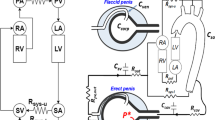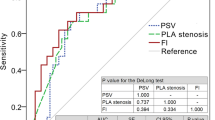Abstract
The results of different vascular tests used in the diagnosis of cavernosal arterial insufficiency and cavernosal venous leakage were compared in 168 men, with an average age of 62.9 y to determine which were the most reliable. One hundred and forty-five men had penile arterial insufficiency demonstrated with digital subtraction pharmacoangiography. The penobrachial index correctly identified 87 of the 145 men with penile arterial insufficiency whereas cavernosal artery peak systolic velocity identified 130 men and cavernosal artery occlusion pressures identified 136 men.
Ninety-six men had cavernosal venous leakage demonstrated during dynamic infusion cavernosometry and cavernosography. The correlation between maintenance flow rate (Qm) and cavernosal pressure decay rate during pressure loss cavernosometry (dccp) was good (R=0.95). The Resistance Index (RI) calculated during cavernosal duplex ultrasonography determined 15 min after vasodilator challenge corrected identified 93 out of 96 venous leakers and 68 of the 72 non-venous leakers. However, the Resistance Index (RI) determined 5 min after vasodilator challenge whilst correctly identifying all 96 venous leakers, identified only 5 of the 72 non-venous leakers and incorrectly categorising the remaining 67 non-leakers as having venous leakage.
In conclusion, both the peak systolic velocity and cavernosal artery occlusion pressure are accurate predictors of cavernosal artery insufficiency, whereas the penobrachial index is a poor predictor. Cavernosal duplex ultrasonography appears as reliable as angiography, is less invasive and more cost effective. The RI is an accurate predictor of cavernosal venous leakage only if determined once maximal response to vasodilator challenge has occurred.
This is a preview of subscription content, access via your institution
Access options
Subscribe to this journal
Receive 8 print issues and online access
$259.00 per year
only $32.38 per issue
Buy this article
- Purchase on Springer Link
- Instant access to full article PDF
Prices may be subject to local taxes which are calculated during checkout
Similar content being viewed by others
Author information
Authors and Affiliations
Rights and permissions
About this article
Cite this article
McMahon, C. Correlation of penile duplex ultrasonography, PBI, DICC and angiography in the diagnosis of impotence. Int J Impot Res 10, 153–158 (1998). https://doi.org/10.1038/sj.ijir.3900346
Received:
Revised:
Accepted:
Published:
Issue Date:
DOI: https://doi.org/10.1038/sj.ijir.3900346
Keywords
This article is cited by
-
Analyse d'articles — avec la collaboration de la Société Francophone de Médecine Sexuelle (SFMS)
Basic and Clinical Andrology (2012)
-
Pharmaco-écho-doppler pénien: méthodologie, critères diagnostiques et indications actuelles dans l’exploration d’une dysfonction érectile
Basic and Clinical Andrology (2012)



